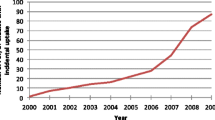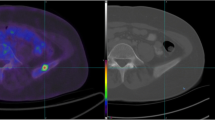Abstract
Purpose
To assess the contribution of concurrent low-dose, noncontrast CT in the assessment of the malignant potential of incidental focal 2-deoxy-2-[F-18]fluoro-d-glucose (FDG)-avid colonic lesions on positron emission tomography/computed tomography (PET/CT).
Procedures
Routine FDG-PET/CT scans were reviewed for identification of focal FDG-avid colon lesions, and the CT component was independently reviewed for an anatomical lesion and malignant potential based on CT criteria. Clinical, endoscopic, and histopathology follow-up was obtained.
Results
A total of 85/2,916 (3%) oncology FDG-PET/CT scans had incidental focal colon lesions. Clinical and/or endoscopic follow-up was available in 83/85 (98%) patients. Focal, corresponding CT lesions were found in 44/83 (53%) patients, but features of malignancy were not assessable. Of the 44 patients with a final diagnosis, 32/44 (73%) were FDG-PET/CT true positives; 5/44 (11%) were false positives; and 7/44 (16%) had inconclusive FDG-PET/CT findings.
Conclusions
Concurrent low-dose, noncontrast CT improves localization, but does not provide independent information on the malignant potential of incidental focal colonic activity on FDG-PET/CT.


Similar content being viewed by others
References
Scott AM (2001) Current status of positron emission tomography in oncology. Intern Med J 31:27–36
Bar-Shalom R, Valdivia AY, Blaufox MD (2000) PET imaging in oncology. Semin Nucl Med 30:150–185
Strauss LG, Conti PS (1991) The applications of PET in clinical oncology. J Nucl Med 32:623–648, discussion 649–650
Israel O, Yefremov N, Bar-Shalom R, et al. (2005) PET/CT detection of unexpected gastrointestinal foci of 18F-FDG uptake: incidence, localization patterns, and clinical significance. J Nucl Med 46:758–762
Francis IR, Brown RK, Avram AM (2005) The clinical role of CT/PET in oncology: an update. Cancer Imaging 5:S68–S75
Bar-Shalom R, Yefremov N, Guralnik L, et al. (2003) Clinical performance of PET/CT in evaluation of cancer: additional value for diagnostic imaging and patient management. J Nucl Med 44:1200–1209
Hannah A, Scott AM, Akhurst T, et al. (1996) Abnormal colonic accumulation of fluorine-18-FDG in pseudomembranous colitis. J Nucl Med 37:1683–1685
Shreve PD, Anzai Y, Wahl RL (1999) Pitfalls in oncologic diagnosis with FDG PET imaging: physiologic and benign variants. Radiographics 19:61–77, quiz 150–151
Kamel EM, Thumshirn M, Truninger K, et al. (2004) Significance of incidental 18F-FDG accumulations in the gastrointestinal tract in PET/CT: correlation with endoscopic and histopathologic results. J Nucl Med 45:1804–1810
Pandit-Taskar N, Schoder H, Gonen M, et al. (2004) Clinical significance of unexplained abnormal focal FDG uptake in the abdomen during whole-body PET. AJR Am J Roentgenol 183:1143–1147
Tatlidil R, Jadvar H, Bading JR, et al. (2002) Incidental colonic fluorodeoxyglucose uptake: correlation with colonoscopic and histopathologic findings. Radiology 224:783–787
Arslan N, Dehdashti F, Siegel BA (2005) FDG uptake in colonic villous adenomas. Ann Nucl Med 19:331–334
Yasuda S, Fujii H, Nakahara T, et al. (2001) 18F-FDG PET detection of colonic adenomas. J Nucl Med 42:989–992
Winawer SJ, Zauber AG (2001) Colonoscopic polypectomy and the incidence of colorectal cancer. Gut 48:753–754
Xiong L, Chintapalli KN, Dodd GD 3rd, et al. (2004) Frequency and CT patterns of bowel wall thickening proximal to cancer of the colon. AJR Am J Roentgenol 182:905–909
Pereira JM, Sirlin CB, Pinto PS, et al. (2004) Disproportionate fat stranding: a helpful CT sign in patients with acute abdominal pain. Radiographics 24:703–715
Moraitis D, Singh P, Jayadevan R, et al. (2006) Colonic wall thickening on computed tomography scan and clinical correlation. Does it suggest the presence of an underlying neoplasia? Am Surg 72:269–271
Zhuang H, Hickeson M, Chacko TK, et al. (2002) Incidental detection of colon cancer by FDG positron emission tomography in patients examined for pulmonary nodules. Clin Nucl Med 27:628–632
Choi JY, Lee KS, Kwon OJ, et al. (2005) Improved detection of second primary cancer using integrated [18F] fluorodeoxyglucose positron emission tomography and computed tomography for initial tumor staging. J Clin Oncol 23:7654–7659
Hara AK, Johnson CD, MacCarty RL, et al. (2001) CT colonography: single- versus multi-detector row imaging. Radiology 219:461–465
Veit P, Kuhle C, Beyer T, et al. (2006) Whole body positron emission tomography/computed tomography (PET/CT) tumour staging with integrated PET/CT colonography: technical feasibility and first experiences in patients with colorectal cancer. Gut 55:68–73
Schoepf UJ, Becker CR, Obuchowski NA, et al. (2001) Multi-slice computed tomography as a screening tool for colon cancer, lung cancer and coronary artery disease. Eur Radiol 11:1975–1985
Pickhardt PJ, Choi JR, Hwang I, et al. (2003) Computed tomographic virtual colonoscopy to screen for colorectal neoplasia in asymptomatic adults. N Engl J Med 349:2191–2200
Macari M, Bini EJ, Jacobs SL, et al. (2004) Significance of missed polyps at CT colonography. AJR Am J Roentgenol 183:127–134
Cotton PB, Durkalski VL, Pineau BC, et al. (2004) Computed tomographic colonography (virtual colonoscopy): a multicenter comparison with standard colonoscopy for detection of colorectal neoplasia. JAMA 291:1713–1719
Macari M, Bini EJ (2005) CT colonography: where have we been and where are we going? Radiology 237:819–833
Iannaccone R, Catalano C, Mangiapane F, et al. (2005) Colorectal polyps: detection with low-dose multi-detector row helical CT colonography versus two sequential colonoscopies. Radiology 237:927–937
Agress H Jr, Cooper BZ (2004) Detection of clinically unexpected malignant and premalignant tumors with whole-body FDG PET: histopathologic comparison. Radiology 230:417–422
Gutman F, Alberini JL, Wartski M, et al. (2005) Incidental colonic focal lesions detected by FDG PET/CT. AJR Am J Roentgenol 185:495–500
Bond JH (2001) Clinical relevance of the small colorectal polyp. Endoscopy 33:454–457
Church JM (2004) Clinical significance of small colorectal polyps. Dis Colon Rectum 47:481–485
Ishimori T, Patel PV, Wahl RL (2005) Detection of unexpected additional primary malignancies with PET/CT. J Nucl Med 46:752–757
Author information
Authors and Affiliations
Corresponding author
Rights and permissions
About this article
Cite this article
Lee, S.T., Tan, T., Poon, A.M.T. et al. Role of Low-dose, Noncontrast Computed Tomography from Integrated Positron Emission Tomography/Computed Tomography in Evaluating Incidental 2-Deoxy-2-[F-18]fluoro-d-glucose-avid Colon Lesions. Mol Imaging Biol 10, 48–53 (2008). https://doi.org/10.1007/s11307-007-0117-0
Received:
Accepted:
Published:
Issue Date:
DOI: https://doi.org/10.1007/s11307-007-0117-0




